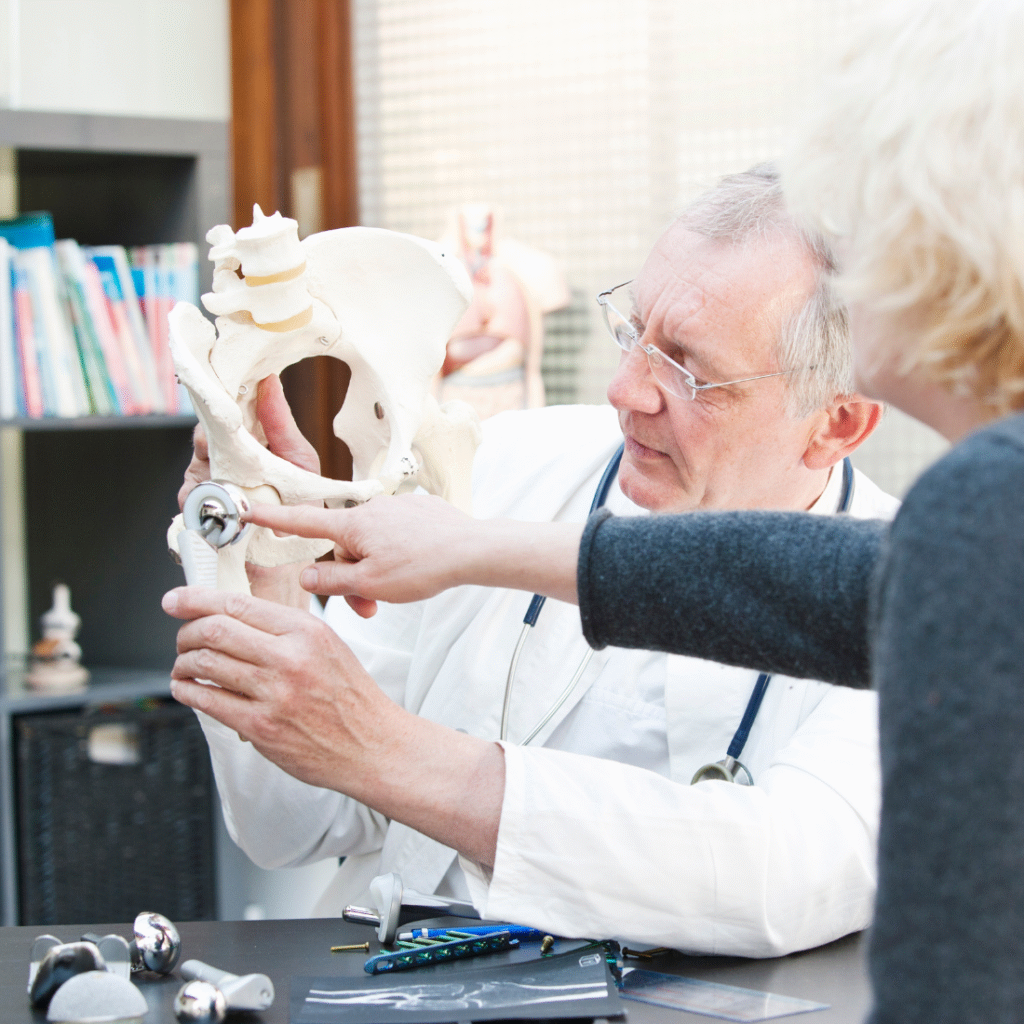A Minimally Invasive Procedure
Direct Anterior Total Hip Arthroplasty is a minimally invasive procedure that in some cases can be considered an outpatient operation.
It involves replacing the hip joint, cup, femoral head, and neck with a prosthetic component.
The direct anterior and anatomic approach, plus Dr. DePaolo’s two decades of experience will allow for a minimal incision site and very rapid recovery.
Quick Facts

- There are close to half a million total hip arthroplasty procedures performed in the US each year.
- The greatest advantages of Dr. DePaolo’s anatomic approach to direct anterior arthroplasty procedure are the faster recovery time and more cosmetically appealing, minimally invasive, incision site.
- Due to the direct approach of the procedure, your recovery may require far less physical therapy and recovery time.
- Patients can go from needing a walker or cane to total freedom, requiring no support at all.
The Process
- Once you’ve decided to have hip replacement surgery, you’ll arrange an appointment to meet Dr. DePaolo and go over any questions you may have about the procedure and recovery, getting to know Dr. DePaolo, his personality, and his staff.
- Next, we’ll need to make sure that you’re healthy enough to recover from the surgery, getting clearance from any primary care doctors, and/or cardiologist if needed.
- Then we’ll discuss the recovery process and pain management techniques, physical therapy, and rest.
- Finally, we will set an appointment for the procedure, making sure that you are on the best path to a total recovery.
The Direct Anterior Hip Replacement Experience
Your overall condition and health will impact the overall experience. Generally speaking, the minimally invasive nature of this procedure will offer you minimal discomfort and mild sensations of pain. You and your doctor will discuss the possibilities and differences between general and regional anesthesia.

Healthy individuals with a lowered risk of complication will be sure-fire candidates for general anesthesia. Other individuals with preexisting conditions and other complications will possibly require regional anesthesia. As you may already know, regional anesthesia is also spinal anesthesia administered directly into the spine without losing consciousness.
Possibly The Simplest Procedure You’ve Ever Had!
Either way, the procedure will take several hours. If you’re a candidate for general anesthesia, you can expect to feel as if the entire procedure happened in the blink of an eye. Before you know it, you’ll be in post-operative care on your way to making a full recovery.

The good news is that within hours of undergoing your direct anterior hip replacement, you can expect to get moving. Having access to a quality surgeon like Dr. DePaolo, as well as the best pain meds and quality nursing staff from Dr. DePaolo’ Orthopedics of Western North Carolina will help you get on your feet before you can say thanks doc!
Why Choose Dr. DePaolo For A Direct Anterior Hip Replacement?
Dr. DePaolo Orthopedics of Western North Carolina is a leader in all Orthopedic medicine and is one of the most well-respected surgeons in North Carolina. When it comes to offering a truly minimally invasive experience, you want to work with a skilled surgeon that understands the ins and out of Direct Anterior Total Hip Arthroplasties.
You may have been doing some research and discovered that a Direct Anterior Total Hip Arthroplasty has been proven to offer a more subtle surgical experience and all-around faster recovery. As a board-certified orthopedic surgeon and sports medicine physician, Dr. DePaolo understands how delicate your situation may be. You can have peace of mind that your best interest will always come first. Schedule an initial consultation today to experience the Dr. DePaolo difference.

Specializing In Orthopedic Surgery For Over 20 Years!
Are you ready to regain your mobility and live the life you’re used to? Life can be a fragile thing at times but modern medicine stands ready to help you regain your strength. Through coordinating various studies and participating in NIH trials, Dr. DePaolo has his finger on the beating pulse of innovation within the world of Orthopedics.
The Traditional Hip Replacement Is Out — Direct Anterior Total Hip Arthroplasty Is In

The incredibly intrusive traditional replacement physically comes with more risks and complications than you may be aware of. Replacing the natural hip involves a large and invasive incision that opens you big enough for the surgeon to extract the diseased and damaged bone. Clinical trials have concluded that males will take 2-3 years to become fully recovered from a traditional hip replacement. Advancements in Orthopedic procedures have recently changed everything.
Your Direct Anterior Total Hip Arthroplasty on the other hand will begin with an incision three to four times smaller than a traditional hip replacement. Many of the critical differences you’ll experience in this minimally invasive procedure result in minimal recovery times, less pain, and less of a dependence on mobility tools like canes and walkers after surgery.
But What's The Critical Difference Between The Two?
Have you heard of the term, “muscle-sparing?” This phrase refers to the way a Direct Anterior Total Hip Arthroplasty avoids damaging and repairing tendons and muscles. Dr. DePaolo will instead delicately go around by pushing them aside and moving them back when necessary. This critical difference of inserting the implants without cutting muscles and tendons offers incredible benefits. Before we discuss those benefits, let’s quickly touch on the risks.
Risks Involved In Your Direct Anterior Total Hip Arthroplasty?
Having a Direct Anterior Total Hip Arthroplasty is considered one of the safest procedures you can have. Under the right conditions, the procedure generally produces favorable results. However, like any surgery, there are always a few risks. These are not meant to scare you but rather make you aware of the potential dangers. Dr. DePaolo’s track record is incredibly encouraging and he’ll get you back on the golf course in no time.
Bleeding
Any surgery, no matter the procedure presents the dangers of excessive bleeding. In the event that you lose a significant amount of blood, a transfusion will be required. This happens in less than 1% of hip replacements and is generally never a problem.
Infection
To reduce the chances of infection, we will administer antibiotics before we start the surgery. Additionally, we recommend that you take antibiotics 1 hour before any dental appointment to prevent bacteria from getting into the bloodstream, sticking to the parts, and causing an infection.

Blood Clots In Veins Of Legs
We take this seriously and take extra precautions to ensure clots don’t form. By applying pressure clamps and encouraging you to move your legs immediately after the surgery, we will mediate the chances of blood clots breaking away and traveling to your heart and lungs. Extremely rare, but possible.
Benefits of the Direct Anterior Hip Approach?
As we briefly touched on above, one of the key benefits of this minimally invasive procedure is the sparing of your muscles and soft tissue areas. In addition to providing less pain, this will significantly speed up your overall recovery time. That translates into a more relaxed physical therapy and recovery experience in general. It’s definitely one of the most well-known benefits of the procedure and something to consider.
Studies have shown evidence that supports the link between a speedy 100% recovery and having a Direct Anterior Total Hip Arthroplasty. One of the most astonishing conclusions drawn from that study was that those who have the anterior approach walk out of the hospital on their own much faster and stronger than traditional hip replacement patients.

There are of course a myriad of other benefits that come from this particular procedure. When compared against traditional hip replacements, these benefits become strikingly clear. Some of those benefits may include:
- Shorter incisions
- Reduced soft tissue trauma
- Lowered post-operative pain
- Minimal blood loss
- Shorter surgical time
- Quicker recovery
- Significantly less scarring
- Back on free faster
- Less postoperative restrictions
- Reduced hip dislocations
- Decreased hospital stay
With so many potential benefits, it’s no wonder why an increasing number of patients have decided to opt for this procedure over the traditional hip replacement. When confronting a 2-3 year recovery time, many patients would prefer to seek other, less invasive alternatives.
A New Study Confirms The Benefits Of Direct Anterior Total Hip Arthroplasty Over Traditional Methods
In the world of surgery, new research is constantly providing the medical community with improved procedures and a better understanding of how to solve issues related to fragile, diseased, and damaged bones and cartilage. One such joint which typically requires repair is the hip. And, the latest study published by the NIH, and the World Journal of Orthopedics has shined a light on why the benefits of a Direct Anterior Total Hip Arthroplasty are a game-changer for patients everywhere.
This study has analyzed the method known as the Direct Anterior Approach, or the DAA approach, for effectiveness in reducing hip replacement recovery times. The results of the study conclude that by using the DAA method, patients undergoing a hip replacement can speed up the recovery period and reduce their dependence on post-operative care.

Critical Steps for Effective Post-Op Care

To make sure you achieve the speedy recovery promised by using the DAA method of replacing your hip, it’s important to follow a few careful instructions. For starters, continue to take your prescription medications so that you don’t experience any pain, infections, or discomfort.
Secondly, begin physical therapy in order to ensure a quick and effective recovery. This will help your muscles adjust to the new movements and get used to working hard again. Additionally, make sure to follow your doctor’s nutritional recommendations and avoid tobacco to help keep your body as strong and healthy as possible.
This recent study shows us that the DAA method offered “improvement in functional results” for patients who chose to use this method for hip replacement surgery as opposed to the traditional approach.
Average Recovery Time For Direct Anterior Approach Procedures
If you’re considering using the Direct Anterior Total Hip Arthroplasty approach, it’s important to know that no one person is the same as the next. Your recovery time frame will fluctuate depending on how active you are prior to your surgery, how old you are, and how strictly you adhere to your PT schedule.
Additional health concerns, underlying conditions, or a body that isn’t in the best physical condition could impede recovery times and make the healing process more difficult. For instance, the study cites that “obese patients with poorer proximal skin where the incision” is made may experience wound complications and, not providing your body with the proper nutrients and aftercare needed to heal your body increases the risk for disease.
When patients are able to keep up a healthy weight and healthy habits after their surgery, they’re typically able to experience greater mobility and far less pain. Pretty soon, you’ll be back on your feet and enjoying your old activities.

When to Consider Anterior Hip Replacement Surgery
Most people who need a complete hip replacement are eligible to receive the direct anterior approach. Anyone who is overweight had previous hip surgery, or who has a complicated hip disorder should stick to more traditional methods of hip replacement to ensure success.
Typically, anyone who is not able to fulfill daily activities, but is in good health and is slightly younger, are better suited for a Direct Anterior Total Hip Arthroplasty. Still, these patients will need to adhere to the post-op physical therapy recommended previously to help them regain mobility and preserve the hip replacement.

Unfortunately, not every candidate is someone who should consider the Direct Anterior Total Hip Arthroplasty. The study discussed above suggests that patients with additional soft tissue carried by obesity or extremely muscular patients could lead to greater difficulty in making surgical cuts to access the hips.
Regardless, the Direct Anterior Total Hip Arthroplasty method has shown that overall there is “less damage to the gluteus medius and minimus with the anterior approach.” In essence, the DAA method may be the best way for surgeons to access the hip joint and conduct effective, minimally damaging surgeries.
Types Of Direct Anterior Total Hip Arthroplasty Implant Materials
You will discuss materials and what’s best for you with Dr. DePaolo. To help you get started on doing your own research, here are the most
Commonly used configurations and material types used today.
Metal on Metal (MOM)
This configuration occurs when the socket and ball components are both metals. The specific type of metal can often times be a combination of metals. Some of the materials your metal on metal configuration may utilize are titanium, cobalt-chromium alloys, or cobalt mixed metals.
The use of metal on metal offers an incredibly strong and durable set up that will provide the most strength. speed and agility within the rotation of your hip. Say goodby to painful cartilage damage, protruding bone spurs, and hello to a new fully metallic replacement.
Polyethylene and Metal on Polyethylene (MOP)
This configuration utilizes a high quality metallic free plastic known as Polyethylene. Either the socket or acetabular liner can be made from plastic when in this configuration. In addition to those two components, other sections of the implant can be made from either metal or plastic. If your socket is plastic and the ball is made from high-quality metal, your configuration will be known as MOP. The opposite is also possible. Sometimes, the socket can be made from a rough metal while the ball is Polyethylene.

Ceramic on Metal (COM), Ceramic on Polyethylene (COP), Ceramic on Ceramic (COC)
You’ll find that ceramic is used much less than other materials and some surgeons will never use it at all. When ceramic is used, it is always combined with other metallic or plastic components. Ceramic is known to be an extremely durable substance. Even so, they have been known to malfunction faster than metallic parts. Recent advancements in technology have been changing our understanding and some even argue that modern ceramic can outperform metal.
Speak With A Specialist
It’s not just the approach used in the treatment that matters. It’s also the experience and skill of the surgeon performing the task! And, the willingness of the patient to attend physical therapy after the procedure will also impact how successful or unsuccessful an operation is.
To make sure your hip replacement surgery goes the way that it should, you need to speak with an orthopedic surgeon who truly understands your body and the nuances required for your surgery.
Dr. DePaolo is no stranger to any approach when it comes to hip replacement surgery.
Advancing The Field Of Medicine

Dr. DePaolo isn’t just your orthopedic surgeon. He’s a force of innovation and expertise helping to advance the study of newer and more effective surgical procedures. With over 20 years of coordinating clinical trials and NIH studies, Dr. DePaolo understands what it will mean to regain your mobility.
He’ll provide you with orthopedic surgery that helps get back on your feet and take control of your life once more. Schedule an appointment with Dr. DePaolo today!



